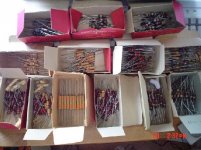This may sound obvious, but if you haven't built an amp before, it may help:
Make sure you lay out your amp so that adjusting the bias is easy. That is, make sure you are able to easily get to the bias pot P1 after the amp is constructed!
Make sure you lay out your amp so that adjusting the bias is easy. That is, make sure you are able to easily get to the bias pot P1 after the amp is constructed!
I forgot to add:
When selecting a resistor for L/R, make sure you get one that is non-magnetic. This is so the coil wrapped around it does not saturate. The old carbon comp resistors were perfect for this, as they also had a nice cylindrical shape that made it easier to wrap around than modern shapes. Also, carbon comps are inherently non-inductive. However, they are hard to find these days, unless you dig them out of old equipment; or expensive, because they are sought after by tube dudes. They are also good for the Zoebel capacitor because they are non-inductive. Their electrical noise does not really matter here.
One trick for winding the inductor is to wind it around a pencil first, before mounting it on the resistor. Use as large a gauge wire as you can find to minimize resistance.
The 10 ohm value for the resistor is not critical. A smaller value would be even better, as Doug Self found out by experimentation. The amplitude of the damped oscillation decreased as the resistor value decreased down to 1 ohm.
When selecting a resistor for L/R, make sure you get one that is non-magnetic. This is so the coil wrapped around it does not saturate. The old carbon comp resistors were perfect for this, as they also had a nice cylindrical shape that made it easier to wrap around than modern shapes. Also, carbon comps are inherently non-inductive. However, they are hard to find these days, unless you dig them out of old equipment; or expensive, because they are sought after by tube dudes. They are also good for the Zoebel capacitor because they are non-inductive. Their electrical noise does not really matter here.
One trick for winding the inductor is to wind it around a pencil first, before mounting it on the resistor. Use as large a gauge wire as you can find to minimize resistance.
The 10 ohm value for the resistor is not critical. A smaller value would be even better, as Doug Self found out by experimentation. The amplitude of the damped oscillation decreased as the resistor value decreased down to 1 ohm.
Another option for preventing inductor saturation would be to mount the inductor to the side of the resistor, instead of around it. I believe the idea of wrapping around the resistor it to give you a nice form for wrapping, more then anything else. I have an amp where the inductor is mounter under the resistor and perpendicular to it. I'll try to find a pic...
Well, I didn't find a pic of them mounted, but here's a pic of the inductors with the resistor, I think you can figure out how they are mounted...
http://www.diyaudio.com/forums/attachment.php?s=&postid=553351&stamp=1105877368
Well, I didn't find a pic of them mounted, but here's a pic of the inductors with the resistor, I think you can figure out how they are mounted...
http://www.diyaudio.com/forums/attachment.php?s=&postid=553351&stamp=1105877368
Attachments
Looks like with a minimal amount of postage, a few of those carbon comps could easily get to my mailbox. 😀
Jens,
Ain't this just the way life goes. OnSemi now has MJL3281/1302 output devices, one of their best against beta droop, with thermal tracking diodes built in:
Thermal track application note
Here is the spec sheet for the transistors:
NDL3281/1302
A circuit is never done!
Ain't this just the way life goes. OnSemi now has MJL3281/1302 output devices, one of their best against beta droop, with thermal tracking diodes built in:
Thermal track application note
Here is the spec sheet for the transistors:
NDL3281/1302
A circuit is never done!
It looks like they have the thermal track diode available with the 4302/4281 package, also
NJL4281D/NJL4302D
NJL4281D/NJL4302D
mlloyd1 said:pooge:
you can even mount it like this (TO126 package instead of TO220):
http://www.diyaudio.com/forums/attachment.php?s=&postid=687023&stamp=1121967453
Don't let me talk you out of mounting the sensor this way. In Self's study of thermal tracking, he found that putting the sensor on a TO-3 device caused overcompensation. However, he found that putting a thermal resistance between the device and the sensor worked better over the long term. Interestingly, the thermal resistance he found suitable is about the same thermal resistance of the plastic package's junction-to-ambient resistance, so there you go.
All boards had been shipped out. Jens--look for yours at the end of the week or early next week.
JonDoe--have no idea what is the post speed to Romania, but it is shipped.
All extra boards are gone also.
JonDoe--have no idea what is the post speed to Romania, but it is shipped.
All extra boards are gone also.
don't worry, you won't. 😉
i actually haven't decided what I'm going to do yet. I provided the pics to fuel ideas and discussion.
i actually haven't decided what I'm going to do yet. I provided the pics to fuel ideas and discussion.
pooge said:
Don't let me talk you out of mounting the sensor this way. In Self's study of thermal tracking, he found that putting the sensor on a TO-3 device caused overcompensation. However, he found that putting a thermal resistance between the device and the sensor worked better over the long term. Interestingly, the thermal resistance he found suitable is about the same thermal resistance of the plastic package's junction-to-ambient resistance, so there you go.
- Status
- Not open for further replies.
- Home
- Amplifiers
- Solid State
- Smaller Leach Amp V1


 they are perfect,
they are perfect,
